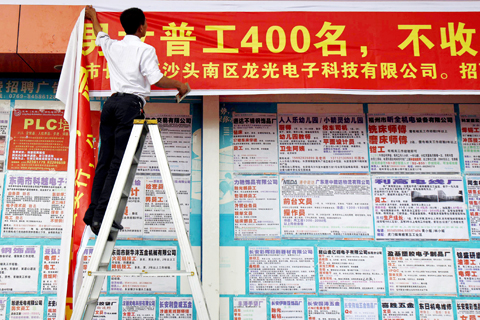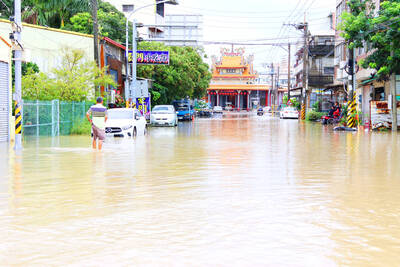After a crisis that sparked mass layoffs in China’s export hubs, factories in manufacturing heartlands such as the Pearl River Delta are on the hunt for migrant workers again as orders revive for Christmas.
In recent visits to three Pearl River Delta towns, a fragmented though consistent picture of labor shortages has emerged, with big job recruitment centers such as CHTONE in Changan experiencing a surge in activity.
“We’re seeing more of that now,” said Zhang Mingming, a bespectacled young manager at the job center where a large red banner over the main entrance advertised 400 new jobs at an electronics factory.

PHOTO: REUTERS
Only a few months ago, such factories were laying off staff by the thousands and a mass reverse migration was taking place as millions of out-of-work workers streamed back to their villages in rural China to wait for the economy to pick up.
Now, with factories in China’s Pearl River Delta ratcheting up production to meet Christmas orders for everything from Barbie dolls to iPhones, Plasma TVs and designer jeans, workers are in high demand in a region that produces about one third of China’s total exports.
Yet finding those workers is another thing entirely as many of the millions of migrant workers who returned home have stayed there, unwilling to make a rash return to the fickle job market in China’s “world factory,” as the Pearl River Delta is known.
“For every 10 people we look for, we can only find two or three,” said Huang Zhilian, a manager at Vmart electronics, a firm that exports calculators, watches and DVD players to emerging markets such as Romania and Pakistan.
Slumped behind a recruitment booth at a job center in Shenzhen’s Longgang town, Huang said he’d only managed to hire six people in the past three days.
“We come here every day now, there’s no choice,” Huang said.
Jobs have become more plentiful and better paid in China’s interior thanks to Beijing’s 4 trillion yuan (US$585 billion) stimulus package which included major spending in underdeveloped parts of the country so the country’s job market would be less dependent on export hubs.
It’s not just the Pearl River Delta that is scrambling to find workers. Other industrial belts are also facing labor shortages such as Zhejiang, in the eastern Yangtze River Delta, where state media says there is a shortage of 250,000 workers.
“We’ve had millions of pieces of reorders in the last two months. [In the] last two years there was nothing,” said Bruce Rockowitz, president of export powerhouse Li & Fung that sources consumer goods extensively for the likes of Walmart, the world’s biggest retailer.
The demand for workers is putting upward pressure on wages, potentially eating into the already wafer-thin factory margins.
“Wages had come way down and now they’re starting to inch up again because a lot of the labor had migrated away,” he said.
While it remains to be seen whether China’s migrant workers will stream back to the Delta, the recent labor strains underscore a growing need for the region to upgrade so as to reduce its reliance on low-end labor-intensive industries.
And while labor supply shortages aren’t a new phenomenon, a demographic shift among China’s 150 million migrant worker population, suggests more and more are now content to stay home, rather than provide the muscle to power coastal export hubs.
“During the financial crisis many people returned home and once home, they don’t want to come out again,” said Lu Kewang, a young migrant worker from Guizhou Province working at the Group Sense electronics factory in Dongguan’s Changan town.
While job centers are often teeming, workers are becoming more picky, preferring work at bigger factories and holding off for better pay, leading to creeping wage inflation in some parts.
Of the 20 million migrant workers out of work early this year, some 14 million or so across China had found work by June, the National Bureau of Statistics said.
While the report didn’t give a regional breakdown, it said 66.7 percent of migrant workers took jobs in eastern coastal areas, while 32.9 percent found work in central and western China, suggesting a significant number were now staying in the interior.
“Before, China was poor, so this region was very attractive,” said Liu Hong, head of the Longguan job market in Shenzhen’s Longgang district.
“Wages and benefits were many times higher than the inland but because of China’s economic development, the difference is getting less and less, so fewer people are coming out here,” he said.
The improved situation on the ground accords with recent purchasing managers’ index data suggesting orders are on the rise, but overall trade numbers remain weak suggesting the uptick isn’t yet across the board, with Chinese exports in August falling a steep 23.4 percent year-on-year.
“The orders have become smaller, less frequent and with a shorter period of delivery … the orders are not continuous like before,” said Hu Yifan, chief economist at Citic Securities.
“The recovery of exports will stabilize, but not be very strong going forward,” she said.
China’s export sector now makes up roughly a third of its GDP and exports are vital in providing long-term employment for China’s masses.
Meanwhile, many of the Delta’s masses of small factories are still scrambling from one order to the next. Instead large firms seem to be gleaning the lion’s share of business and mopping up most surplus labor.
For minnows like the Yuang Kang toy factory in Dongguan which makes stuffed dolls including podgy Santa Clauses and grinning snowmen, there’s not much to cheer about this Christmas.
“Things are just OK,” said Zhang Guopin, a sales manager for the firm. “We haven’t seen much improvement in our business.”

WAITING GAME: The US has so far only offered a ‘best rate tariff,’ which officials assume is about 15 percent, the same as Japan, a person familiar with the matter said Taiwan and the US have completed “technical consultations” regarding tariffs and a finalized rate is expected to be released soon, Executive Yuan spokeswoman Michelle Lee (李慧芝) told a news conference yesterday, as a 90-day pause on US President Donald Trump’s “reciprocal” tariffs is set to expire today. The two countries have reached a “certain degree of consensus” on issues such as tariffs, nontariff trade barriers, trade facilitation, supply chain resilience and economic security, Lee said. They also discussed opportunities for cooperation, investment and procurement, she said. A joint statement is still being negotiated and would be released once the US government has made

NEW GEAR: On top of the new Tien Kung IV air defense missiles, the military is expected to place orders for a new combat vehicle next year for delivery in 2028 Mass production of Tien Kung IV (Sky Bow IV) missiles is expected to start next year, with plans to order 122 pods, the Ministry of National Defense’s (MND) latest list of regulated military material showed. The document said that the armed forces would obtain 46 pods of the air defense missiles next year and 76 pods the year after that. The Tien Kung IV is designed to intercept cruise missiles and ballistic missiles to an altitude of 70km, compared with the 60km maximum altitude achieved by the Missile Segment Enhancement variant of PAC-3 systems. A defense source said yesterday that the number of

Taiwanese exports to the US are to be subject to a 20 percent tariff starting on Thursday next week, according to an executive order signed by US President Donald Trump yesterday. The 20 percent levy was the same as the tariffs imposed on Vietnam, Sri Lanka and Bangladesh by Trump. It was higher than the tariffs imposed on Japan, South Korea and the EU (15 percent), as well as those on the Philippines (19 percent). A Taiwan official with knowledge of the matter said it is a "phased" tariff rate, and negotiations would continue. "Once negotiations conclude, Taiwan will obtain a better

FLOOD RECOVERY: “Post-Typhoon Danas reconstruction special act” is expected to be approved on Thursday, the premier said, adding the flood control in affected areas would be prioritized About 200cm of rainfall fell in parts of southern Taiwan from Monday last week to 9am yesterday, the Central Weather Administration (CWA) said. Kaohsiung’s Taoyuan District (桃源) saw total rainfall of 2,205mm, while Pingtung County’s Sandimen Township (三地門) had 2,060.5mm and Tainan’s Nanhua District (南化) 1,833mm, according to CWA data. Meanwhile, Alishan (阿里山) in Chiayi County saw 1,688mm of accumulated rain and Yunlin County’s Caoling (草嶺) had 1,025mm. The Pingtung County Government said that 831 local residents have been pre-emptively evacuated from mountainous areas. A total of 576 are staying with relatives in low-lying areas, while the other 255 are in shelters. CWA forecaster